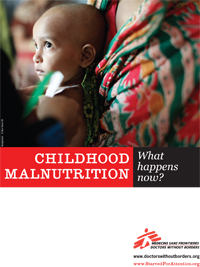While Young Victims of War and Famine Are Able to Access Latest Lifesaving, Nutritious Foods, Millions More Malnourished Children Still Receive Poor Quality Food Aid
Despite some recent gains in the fight against childhood malnutrition, the global food aid system largely continues to provide substandard foods to millions of malnourished children.
NEW YORK, OCTOBER 13, 2011 – Despite some recent gains in the fight against childhood malnutrition, the global food aid system—led by the United States—largely continues to provide substandard foods to millions of malnourished children every year, the international medical humanitarian organization Doctors Without Borders/Médecins Sans Frontières (MSF) announced today, in advance of World Food Day on October 16.
Malnutrition—a preventable and treatable condition—afflicts an estimated 195 million children worldwide and is the underlying cause of at least one-third of the eight million annual deaths of children under five years of age, the vast majority of which occur in the developing world.
Children under the age of two are the most vulnerable to the consequences of malnutrition, and without access to nutrient-dense foods necessary for growth and development, such as highly effective ready-to-use supplementary foods now available, they will suffer debilitating lifelong consequences.
“It’s been proven beyond any doubt that getting nutritionally appropriate foods to young, vulnerable children saves their lives, yet the global food aid system has not fully caught up with the revolutionary gains made in nutrition science,” said Dr. Unni Karunakara, MSF’s international president.
The bulk of international food aid shipments, including those sent to countries with a high burden of malnutrition, such as parts of sub-Saharan Africa, are comprised of corn-soy blend (CSB) fortified flours, which do not include the vital nutrients and proteins growing children require. The United States alone annually ships approximately 130,000 metric tons of sub-standard CSB—grown and processed on American farms—to the developing world.
While initiatives led by the US government, such as the “1,000 days” campaign or “Scaling Up Nutrition” (SUN), bring together countries featuring high levels of malnutrition with major international food donors—demonstrating that there is a scientific and political consensus on the need to focus on children under two—most food aid today does not provide appropriate nutrition to young children.
“The catalog of products available for food aid grossly neglects the needs of the most vulnerable,” said Dr. Karunakara. “There’s no excuse for waiting anymore; the world’s major food aid donor countries need to finally get on board.”
MSF today sent letters to representatives of the top food aid donor countries, including the US, European Union member states, Canada, and Brazil. The letters were sent on behalf of more than 133,000 individuals from over 180 countries who signed a petition, demanding that donor nations “stop supplying nutritionally substandard food to malnourished children and children at risk of malnutrition in developing countries.”
In a letter to Secretary of State Hillary Clinton, USAID Administrator Rajiv Shah, and Secretary of Agriculture Tom Vilsack, MSF-USA Executive Director Sophie Delaunay urged the US government to apply the same nutrition standards to the food it sends overseas as it does through the Special Supplemental Nutrition Program for Women, Infants, and Children (WIC), which ensures that low-income American families have access to quality, nutritious foods.
“As the world’s largest food aid donor, the policies and practices of the U.S. are enormously influential in assuring that the right foods reach the right people at the right time,” the letter said.
Some key food aid players have begun to change. The World Food Program, for example, now uses supplementary foods that meet the nutritional needs of children under two as the cornerstone of its interventions in medical emergencies. Such products played a key role in 2010 in response to the nutritional crisis that struck Niger, the floods in Pakistan, and the earthquake in Haiti. And donor nations and aid agencies have improved the quality of foods sent to Somalia and Kenya in response to current nutrition crises there.
Yet the vast majority of malnourished children, who are not caught up in attention-grabbing emergencies, continue to receive products from major international food aid donors that do not meet their specific nutritional needs.
“High profile emergencies, such as those in Somalia and Kenya today, represent just the tip of the malnutrition iceberg,” said Dr. Karunakara. “Most malnourished children are invisible, and they should not have to become victims of war or natural catastrophes in order to have access to the foods they need.”
In late 2008, an expert meeting convened by the World Health Organization (WHO) considered the growing body of scientific evidence and concluded that nutritional standards of food aid needed to be improved. But three years later, the WHO, which most Ministries of Health in developing countries rely on for policy guidance, has yet to issue formal guidelines to ensure the improvement of food for malnourished or young children.
“Guidance from the WHO is crucial to encourage donor countries to adopt better standards for food aid and recipient countries to adopt better measures to ensure their children have access to quality nutrition,” said Dr. Karunakara.
“Children cannot afford the delays caused by having to demonstrate the safety and efficacy of these new specialized foods with every single government from one crisis to the next,” he said. “This only serves to delay the initiation of lifesaving programs.”
In June 2010, MSF and the VII Photo agency launched “Starved for Attention,” a multimedia campaign exposing the neglected and largely invisible crisis of childhood malnutrition. VII photojournalists traveled to malnutrition “hotspots” around the world—from war zones to emerging economies—to shed light on the underlying causes of the malnutrition crisis and innovative approaches to combat this condition, producing eight documentaries, which can be viewed at www.starvedforattention.org.
In 2010, MSF admitted more than 300,000 malnourished patients to feeding centers at 139 projects in 28 countries.





